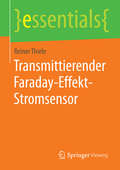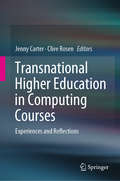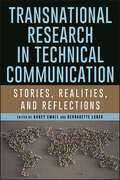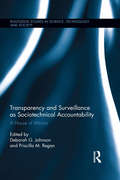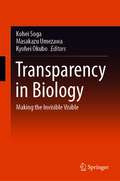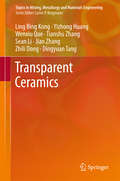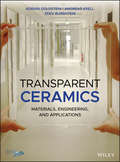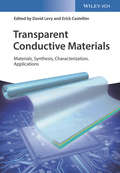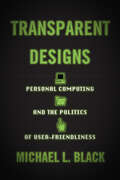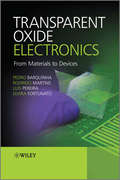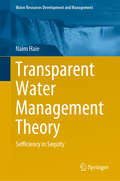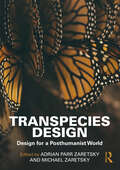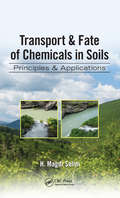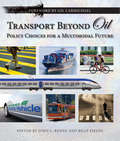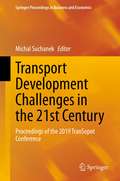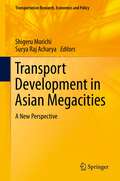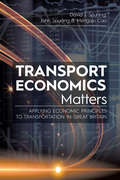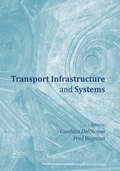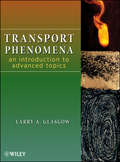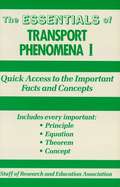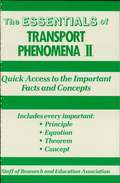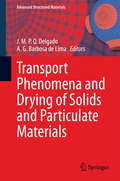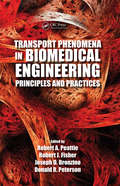- Table View
- List View
Transmissions and Drivetrain Design (Commercial Vehicle Technology)
by Michael HilgersThe aim of this work, consisting of 9 individual, self-contained booklets, is to describe commercial vehicle technology in a way that is clear, concise and illustrative. Compact and easy to understand, it provides an overview of the technology that goes into modern commercial vehicles. Starting from the customer's fundamental requirements, the characteristics and systems that define the design of the vehicles are presented knowledgeably in a series of articles, each of which can be read and studied on their own. This volume, Transmissions and Drivetrain Design, begins with an explanation of how driving resistance and the engine characteristics factor into the configuration of the transmission and transmission ratios. The transmission and its associated assemblies are presented in detail, providing a clear understanding for training and practical applications. Other components of the drivetrain such as the propeller shaft, the clutch and the retarder are also discussed.
Transmittierender Faraday-Effekt-Stromsensor (essentials)
by Reiner ThieleReiner Thiele zeigt die Lösung auf, wie die Messung von hohen elektrischen Strömen ohne Eingriff in den Messgrößenkreis gelingt - ein grundsätzliches Problem der elektrischen Energietechnik. Er schlägt dies durch die Applikation des Faraday-Effektes zur Polarisations-Ebenen-Drehung linear polarisierten Lichts in Lichtwellenleitern vor, induziert durch das den stromführenden elektrischen Leiter umgebende Magnetfeld. Eine in Transmission arbeitende erfindungsgemäße Schaltungsanordnung aus optischen und elektronischen Komponenten stellt dabei den gewünschten linearen Zusammenhang zwischen Messgröße und Messwert bei Elimination der störenden Doppelbrechung der Lichtwellenleiter her, die sich ansonsten vermindernd auf die Effizienz des Faraday-Effektes auswirkt.
Transnational Higher Education in Computing Courses: Experiences and Reflections
by Jenny Carter Clive RosenThere has been exponential growth in transnational education (TNE) in the last few years as UK universities have looked to expand their markets. Recipient countries have sought short cuts to developing their higher education provision which has proved a lucrative income stream for some universities. But overseas collaborations are not without risk. Recipient countries can be concerned with external influence over curricula, quality being diluted and higher education being infected by neo-imperialism. These concerns are not without foundation. There are risks for providers too. Reputations can be damaged if academic standards are compromised. Conflicts of interest can occur between quality of provision and the pot of gold on offer. Staff can view overseas collaborations as distracting from their research and commitment to home students. Computing is a particularly popular subject for TNE, but critical thinking, analysis, independent learning, and creativity can be compromised. Preventing plagiarism is difficult. Constant changes in technology result in constant curricula revision which causes severe problems for overseas collaborations. This book focuses on TNE in the computing domain. However cross-cultural issues challenge TNE management and administration whatever the subject area. If the ever present tensions are not continuously monitored they can quickly threaten the sustainability of the collaboration. This book identifies many of the threats and some of the solutions. The readership for this book is truly global. Any international development officer in higher education considering an overseas collaboration will benefit from this book. Any academic becoming engaged in, or already involved with a TNE partnership, either as provider or recipient, will gain information and insight into the practice and issues. Researchers in TNE will discover more lines of enquiry. Students considering a course with an overseas provider or in coming to the UK to study will be better prepared thereby enabling a more fulfilling and rewarding experience. Anyone who has an interest in TNE, whether at the senior executive level, operational level, delivering programmes or as a recipient of TNE should read this book. The wealth of experience gathered here will provoke questions, prompt debate and offer solutions. It has been written by people who know the issues, bear the scars and are happy to share their knowledge. It will greatly benefit future transnational collaborations.
Transnational Research in Technical Communication: Stories, Realities, and Reflections (SUNY series, Studies in Technical Communication)
by Nancy Small; Bernadette LongoTransnational Research in Technical Communication considers the complexities of intercultural projects from a compelling perspective: first-hand narrative reflections. Readers go behind the scenes as scholars share their experiences crossing a variety of borders in their efforts to engage in knowledge-making endeavors. Interwoven through each chapter are stories of how projects were designed, adapted, and sometimes even failed. The collection begins with an introduction situating it at the intersection of recent scholarship in storywork, intercultural research, and technical and professional communication’s social justice turn. Each chapter concludes with discussion questions and recommendations for further reading. The closing chapter reveals a nascent "ethic of transnational and intercultural research" growing out of contributors' lessons learned and generous reflections. Anyone interested in or planning to undertake a transnational or intercultural project can benefit from these storied case studies, and as a result, this collection contributes to moving the field forward as it strives to promote more ethically aware and responsive research.
Transparency and Surveillance as Sociotechnical Accountability: A House of Mirrors (Routledge Studies in Science, Technology and Society #28)
by Deborah G. Johnson Priscilla M. ReganSurveillance and transparency are both significant and increasingly pervasive activities in neoliberal societies. Surveillance is taken up as a means to achieving security and efficiency; transparency is seen as a mechanism for ensuring compliance or promoting informed consumerism and informed citizenship. Indeed, transparency is often seen as the antidote to the threats and fears of surveillance. This book adopts a novel approach in examining surveillance practices and transparency practices together as parallel systems of accountability. It presents the house of mirrors as a new framework for understanding surveillance and transparency practices instrumented with information technology. The volume centers around five case studies: Campaign Finance Disclosure, Secure Flight, American Red Cross, Google, and Facebook. A series of themed chapters draw on the material and provide cross-case analysis. The volume ends with a chapter on policy implications.
Transparency in Biology: Making the Invisible Visible
by Kohei Soga Masakazu Umezawa Kyohei OkuboThis book explains transparency in biology with emphasis on bending and absorption, which together are the essence of transparency. The reader is provided with an understanding of why the interior of the body can be made to appear transparent through the application of elementary physics. Based on the principle of transparency, emerging imaging techniques using near-infrared light to view the body transparently are explained with examples such as cancer detection and temperature imaging of deep tissues. This book is useful to many researchers, including biologists, physicists, chemists, materials scientists, and device engineers as well as developers—all who seek a deep understanding of transparency in bioimaging.
Transparent Ceramics
by Ling Bing Kong Y. Z. Huang W. X. Que T. S. Zhang S. Li J. Zhang Z. L. Dong D. Y. TangThis book covers the latest progress in the field of transparent ceramics, emphasizing their processing as well as solid-state lasers. It consists of 10 chapters covering the synthesis, characterization and compaction, fundamentals of sintering, densification of transparent ceramics by different methods as well as transparent ceramic applications. This book can be used as a reference for senior undergraduate to postgraduate students, researchers, engineers and material scientists working in solid-state physics.
Transparent Ceramics: Materials, Engineering, and Applications
by Adrian Goldstein Andreas Krell Zeev BurshteinA detailed account of various applications and uses of transparent ceramics and the future of the industry In Transparent Ceramics: Materials, Engineering, and Applications, readers will discover the necessary foundation for understanding transparent ceramics (TCs) and the technical and economic factors that determine the overall worth of TCs. This book provides readers with a thorough history of TCs, as well as a detailed account of the materials, engineering and applications of TC in its various forms; fabrication and characterization specifics are also described. With this book, researchers, engineers, and students find a definitive guide to past and present use cases, and a glimpse into the future of TC materials. The book covers a variety of TC topics, including: ● The methods employed for materials produced in a transparent state ● Detailed applications of TCs for use in lasers, IR domes, armor-windows, and various medical prosthetics ● A review of traditionally used transparent materials that highlights the benefits of TCs ● Theoretical science and engineering theories presented in correlation with learned data ● A look at past, present, and future use-cases of TCs This insightful guide to ceramics that can be fabricated into bulk transparent parts will serve as a must-read for professionals in the industry, as well as students looking to gain a more thorough understanding of the field.
Transparent Conductive Materials: From Materials via Synthesis and Characterization to Applications
by David Levy Erick CastellónEdited by well-known pioneers in the field, this handbook and ready reference provides a comprehensive overview of transparent conductive materials with a strong application focus. Following an introduction to the materials and recent developments, subsequent chapters discuss the synthesis and characterization as well as the deposition techniques that are commonly used for energy harvesting and light emitting applications. Finally, the book concludes with a look at future technological advances. All-encompassing and up-to-date, this interdisciplinary text runs the gamut from chemistry and materials science to engineering, from academia to industry, and from fundamental challenges to readily available applications.
Transparent Designs: Personal Computing and the Politics of User-Friendliness (Studies in Computing and Culture)
by Michael L. BlackThis fascinating cultural history of the personal computer explains how user-friendly design allows tech companies to build systems that we cannot understand.Modern personal computers are easy to use, and their welcoming, user-friendly interfaces encourage us to see them as designed for our individual benefit. Rarely, however, do these interfaces invite us to consider how our individual uses support the broader political and economic strategies of their designers.In Transparent Designs, Michael L. Black revisits early debates from hobbyist newsletters, computing magazines, user manuals, and advertisements about how personal computers could be seen as usable and useful by the average person. Black examines how early personal computers from the Tandy TRS-80 and Commodore PET to the IBM PC and Apple Macintosh were marketed to an American public that was high on the bold promises of the computing revolution but also skeptical about their ability to participate in it. Through this careful archival study, he shows how many of the foundational principles of usability theory were shaped through disagreements over the languages and business strategies developed in response to this skepticism. In short, this book asks us to consider the consequences of a computational culture that is based on the assumption that the average person does not need to know anything about the internal operations of the computers we've come to depend on for everything.Expanding our definition of usability, Transparent Designs examines how popular and technical rhetoric shapes user expectations about what counts as usable and useful as much as or even more so than hardware and software interfaces. Offering a fresh look at the first decade of personal computing, Black highlights how the concept of usability has been leveraged historically to smooth over conflicts between the rhetoric of computing and its material experience. Readers interested in vintage computing, the history of technology, digital rhetoric, or American culture will be fascinated in this book.
Transparent Oxide Electronics
by Rodrigo Martins Pedro Barquinha Elvira Fortunato Luis PereiraTransparent electronics is emerging as one of the most promising technologies for the next generation of electronic products, away from the traditional silicon technology. It is essential for touch display panels, solar cells, LEDs and antistatic coatings.The book describes the concept of transparent electronics, passive and active oxide semiconductors, multicomponent dielectrics and their importance for a new era of novel electronic materials and products. This is followed by a short history of transistors, and how oxides have revolutionized this field. It concludes with a glance at low-cost, disposable and lightweight devices for the next generation of ergonomic and functional discrete devices. Chapters cover:Properties and applications of n-type oxide semiconductors P-type conductors and semiconductors, including copper oxide and tin monoxide Low-temperature processed dielectrics n and p-type thin film transistors (TFTs) - structure, physics and brief history Paper electronics - Paper transistors, paper memories and paper batteries Applications of oxide TFTs - transparent circuits, active matrices for displays and biosensors Written by a team of renowned world experts, Transparent Oxide Electronics: From Materials to Devices gives an overview of the world of transparent electronics, and showcases groundbreaking work on paper transistors
Transparent Water Management Theory: Sefficiency in Sequity (Water Resources Development and Management)
by Naim HaieThis book provides a solid foundation for a comprehensive, systemic and water-centric approach to water management. Said approach integrates two performance principles essential for sustainable water use systems, namely equity and efficiency. Further, it decreases the policy space for decision-making encountered by water managers and makes it easier to arrive at reasonable solutions because of the bounded rationality inherent in its development. By combining the distributive and aggregative principles, the approach offers a transparent and autonomous structure for gathering water data and enabling stakeholder involvement. Lastly, it employs and promotes a unifying language for all types of water use systems, e.g. urban, agricultural and industrial.
Transparent and Flexible MIMO Antenna Technologies for 5G Applications: Transforming 5G with Transparent & Flexible MIMO Antennas (EAI/Springer Innovations in Communication and Computing)
by Yang Li Jayshri Kulkarni Arpan Desai Heng Tung Hsu Brian Garner Chow-Yen-Desmond Sim Vigneswaran DhasarathanThis book presents a comprehensive and in-depth exploration of the intricate design process and advanced modeling techniques employed in the creation of cutting-edge antenna geometries specifically tailored to meet the demands of Sub-6 GHz 5G wireless applications and communication systems. The authors provide valuable insights into the selection of flexible substrates, which serve as the foundation for the production of versatile antennas capable of seamlessly integrating into the rapidly evolving 5G and MIMO landscapes. Delving into the depths of antenna design, this book highlights the key aspects surrounding flexible MIMO antennas, showcasing their remarkable compatibility within compact spaces. The authors elucidate the intricacies involved in creating these antennas, illuminating their ability to adapt to challenging environmental conditions while maintaining exceptional performance. Furthermore, the authors delve into the fascinating realm of optimized flexible antenna arrays for MIMO systems, employing both transparent and non-transparent materials. The development of such arrays entails a meticulous optimization process, where a delicate balance between performance, form factor, and functionality is achieved. By shedding light on this complex process, the book equips readers with the knowledge and tools necessary to engineer high-performing, flexible antenna arrays for advanced wireless communication systems. The book embraces a broad scope by encompassing various substrate materials and fabrication techniques. This inclusive approach ensures its relevance and applicability to a wide range of readers, including novice researchers, postgraduate students, research scholars, as well as seasoned professionals and experts in the field of antennas hailing from diverse industries and academic institutions. Moreover, undergraduate students pursuing degrees in Communication Engineering, Electronics Engineering, and Antennas for Wireless Communication Systems will find this book to be an indispensable resource, offering highly pertinent and enlightening content that bridges the gap between theoretical concepts and real-world antenna design challenges.
Transpecies Design: Design for a Posthumanist World
by Michael Zaretsky Adrian Parr ZaretskyIn May 2019, the United Nations released the Global Assessment Report on Biodiversity and Ecosystem Services which warned that human activities will drive nearly one million species to extinction in a few decades. The primary reasons for this are habitat loss and biodiversity demise caused by changing climate, pollution, introducing nonindigenous species, clearing land, over population, and consumption. Given this situation, humans must change course as both human wellbeing and the wellbeing of other-than-human species are imbricated in one another. One way humanity can accomplish the needed transformation is to move beyond an anthropocentric view of life by embracing a transpecies approach that is premised upon interconnected flourishing.Transpecies design, as outlined in this book, offers a new approach to regenerating the natural environment while honoring biodiversity. Rather than presenting the human experience as the goal of design, transpecies design takes the inextricable linkages connecting living things as both its starting point and end goal. As such, it moves beyond human experience serving as the fundamental ingredient for making better design processes and decisions.This book is essential reading for artists, designers, and architects, as well as students of architecture, landscape architecture, interior architecture, art, product design, urban design, planning, environmental philosophy, and cultural studies.
Transport & Fate of Chemicals in Soils: Principles & Applications
by H. Magdi SelimDuring the last four decades, tremendous advances have been made towards the understanding of transport characteristics of contaminants in soils, solutes, and tracers in geological media. Transport & Fate of Chemicals in Soils: Principles & Applications offers a comprehensive treatment of the subject complete with supporting examples of mat
Transport Beyond Oil: Policy Choices for a Multimodal Future
by John L. Renne Billy Fields Todd Litman David Gates Burwell Gilbert E. Carmichael Neil SipeSeventy percent of the oil America uses each year goes to transportation. That means that the national oil addiction and all its consequences, from climate change to disastrous spills to dependence on foreign markets, can be greatly reduced by changing the way we move. In Transport Beyond Oil, leading experts in transportation, planning, development, and policy show how to achieve this fundamental shift. The authors demonstrate that smarter development and land-use decisions, paired with better transportation systems, can slash energy consumption. John Renne calculates how oil can be saved through a future with more transit-oriented development. Petra Todorovitch examines the promise of high-speed rail. Peter Newman imagines a future without oil for car-dependent cities and regions. Additional topics include funding transit, freight transport, and nonmotorized transportation systems. Each chapter provides policy prescriptions and their measurable results. Transport Beyond Oil delivers practical solutions, based on quantitative data. This fact-based approach offers a new vision of transportation that is both transformational and achievable.
Transport Development Challenges in the 21st Century: Proceedings of the 2019 TranSopot Conference (Springer Proceedings in Business and Economics)
by Michal SuchanekThis proceedings present current trends in the transport growth. It presents transport solutions both at a micro-level, such as that of a single city or a single company, as well as at a macro-level of a whole transportation system. The transport decisions made by an individual in regards to the transport mode and route, add up to the structure and efficiency of the whole system. Transport systems cannot grow extensively anymore, due to lack of space or the amount of additional costs, so the authors presents new solutions, ones which are innovative and sustainable, while also increasing the efficiency of transport operations. These solutions are analyzed for performance at a scale of individual cities or companies, as well as whole transport systems. The researchers, who are often also practitioners in the field of transport, provide not only the theoretical background for the transport analysis but also empirical data and practical experience.
Transport Development in Asian Megacities: A New Perspective
by Shigeru Morichi Surya Raj AcharyaThe rapid growth of the Asian urban population concentrates on a few large cities, turning them into giant megacities. Despite new theoretical insights into the benefits of megacities, the emerging Asia is facing a daunting challenge concerning the management of infrastructure and services in their megacities. The deteriorating urban mobility is the most difficult challenge with respect to the sharp increase in vehicle numbers and to inadequate and poorly managed road infrastructure. Public transport, a sustainable mode of mobility, is subjected to a vicious cycle of poor service, decreasing ridership and lower investment. Despite various policy initiatives, the situation has not improved. The scale and growth pattern of Asian megacities have distinctive features which generate a unique set of challenges and opportunities. New perspectives are needed to effectively address the transportation problems making the best use of available opportunities. This book, which is a result of an international collaborative research, addresses these challenges by providing insightful analysis and novel viewpoints.
Transport Economics Matters: Applying Economic Principles to Transportation in Great Britain
by Mengqiu CaoThis book reveals and discusses existing and potential problems derived from the transport economics domain in relation to their environment, and the social, political and economic impacts, with reference to a wide range of transport modes. It is suitable
Transport Infrastructure and Systems: Proceedings of the AIIT International Congress on Transport Infrastructure and Systems (Rome, Italy, 10-12 April 2017)
by Fred Wegman Gianluca Dell’AcquaTransport InfrastructureAsset management in transport infrastructure, financial viability of transport engineering projects/ Life cycle Cost Analysis, Life-Cycle Assessment and Sustainability Assessment of transport infrastructure/ Infrastructures financing and pricing with equity appraisal, operation optimization and energy management/ Low-Volume roads: planning, maintenance, operations, environmental and social issues/ Public-Private Partnership (PPP) experience in transport infrastructure in different countries and economic conditions/ Airport Pavement Management Systems, runway design and maintenance/ Port maintenance and development issues, technology relating to cargo handling, landside access, cruise operations/ Infrastructure Building Information Modelling (I-BIM) / Pavement design and innovative bituminous materials/ Recycling and re-use in road pavements, environmentally sustainable technologies/ Stone pavements, ancient roads and historic railways/ Cementitious stabilization of materials used in the rehabilitation of transportation infrastructure. Transport SystemsSustainable transport and the environment protection including green vehicles/ Urban transport, land use development, spatial and transport planning/ Bicycling, bike, bike-sharing systems, cycling mobility/ Human factor in transport systems/ Intelligent Mobility: emerging technologies to enable the smarter movement of people and goods/Airport landside: access roads, parking facilities, terminal facilities, aircraft apron and the azdjacent taxiway/ Transportation policy, planning and design, modelling and decision making/ Transport economics, finance and pricing issues, optimization problems, equity appraisal/ Road safety impact assessments, road safety audits, the management of road network safety and safety inspections/ Tunnels and underground structures: preventing incidents-accidents mitigating their effects for both people and goods/ Traffic flow characteristics, traffic control devices, work zone traffic control, highway capacity and quality of service/ Track-vehicle interactions in railway systems, capacity analysis of railway networks/ Risk assessment and safety in air and railway transport, reliability aspects/ Maritime transport and inland waterways transport research/ Intermodal freight transport: terminals and logistics.
Transport Phenomena
by Larry A. GlasgowEnables readers to apply transport phenomena principles to solve advanced problems in all areas of engineering and science This book helps readers elevate their understanding of, and their ability to apply, transport phenomena by introducing a broad range of advanced topics as well as analytical and numerical solution techniques. Readers gain the ability to solve complex problems generally not addressed in undergraduate-level courses, including nonlinear, multidimensional transport, and transient molecular and convective transport scenarios. Avoiding rote memorization, the author emphasizes a dual approach to learning in which physical understanding and problem-solving capability are developed simultaneously. Moreover, the author builds both readers' interest and knowledge by: Demonstrating that transport phenomena are pervasive, affecting every aspect of life Offering historical perspectives to enhance readers' understanding of current theory and methods Providing numerous examples drawn from a broad range of fields in the physical and life sciences and engineering Contextualizing problems in scenarios so that their rationale and significance are clear This text generally avoids the use of commercial software for problem solutions, helping readers cultivate a deeper understanding of how solutions are developed. References throughout the text promote further study and encourage the student to contemplate additional topics in transport phenomena. Transport Phenomena is written for advanced undergraduates and graduate students in chemical and mechanical engineering. Upon mastering the principles and techniques presented in this text, all readers will be better able to critically evaluate a broad range of physical phenomena, processes, and systems across many disciplines.
Transport Phenomena I Essentials
by The Editors of REAREA's Essentials provide quick and easy access to critical information in a variety of different fields, ranging from the most basic to the most advanced. As its name implies, these concise, comprehensive study guides summarize the essentials of the field covered. Essentials are helpful when preparing for exams, doing homework and will remain a lasting reference source for students, teachers, and professionals. Transport Phenomena I includes viscosity, flow of Newtonian fluids, velocity distribution in laminar flow, velocity distributions with more than one independent variable, thermal conductivity and mechanism of energy transport, and steady state heat conduction in one dimension.
Transport Phenomena II Essentials
by The Editors of REAREA's Essentials provide quick and easy access to critical information in a variety of different fields, ranging from the most basic to the most advanced. As its name implies, these concise, comprehensive study guides summarize the essentials of the field covered. Essentials are helpful when preparing for exams, doing homework and will remain a lasting reference source for students, teachers, and professionals. Transport Phenomena II covers forced convention, temperature distribution, free convection, diffusitivity and the mechanism of mass transfer, convective mass transfer, concentration distribution in solids and in laminar flow, and the equation of change for multicomponent systems.
Transport Phenomena and Drying of Solids and Particulate Materials
by J. M. P. Q. Delgado A. G. Barbosa de LimaThe purpose of this book, Transport Phenomena and Drying of Solids and Particulate Materials, is to provide a collection of recent contributions in the field of heat and mass transfer, transport phenomena, drying and wetting of solids and particulate materials. The main benefit of the book is that it discusses some of the most important topics related to the heat and mass transfer in solids and particulate materials. It includes a set of new developments in the field of basic and applied research work on the physical and chemical aspects of heat and mass transfer phenomena, drying and wetting processes, namely, innovations and trends in drying science and technology, drying mechanism and theory, equipment, advanced modelling, complex simulation and experimentation. At the same time, these topics will be going to the encounter of a variety of scientific and engineering disciplines. The book is divided in several chapters that intend to be a resume of the current state of knowledge for benefit of professional colleagues.
Transport Phenomena in Biomedical Engineering: Principles and Practices
by Joseph D. Bronzino Donald R. Peterson Robert A. Peattie Robert J. FisherDesign, analysis and simulation of tissue constructs is an integral part of the ever-evolving field of biomedical engineering. The study of reaction kinetics, particularly when coupled with complex physical phenomena such as the transport of heat, mass and momentum, is required to determine or predict performance of biologically-based systems wheth

